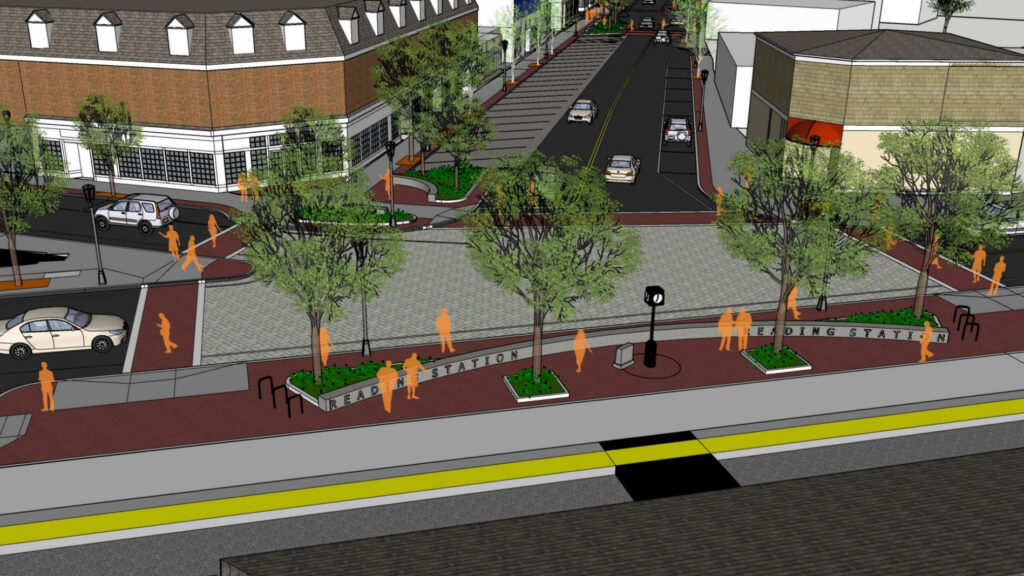
Reading, MA — Town Engineer Ryan Percival, along with Community Development Director Andrew MacNichol and Beta Group landscape architect Scott Ridder, presented preliminary ideas regarding a proposed restructuring of the area around the Reading Depot on April 8. The area includes the lower end of Haven Street and High Street from Woburn Street to Washington Street.
The goal of the proposed project, according to Percival, is to “improve vehicular and pedestrian access to the area” regarding sustainability, walkability, and parking. Percival also indicated that the project could be partially funded through a MassWorks grant that he town received.
CPDC-Meeting-PHASE-2-DRAFT-PresenationRidder continued, indicating that the benefits and goals of a renewed streetscape in the area include a reduction of impervious surface with landscape and materials improvements, making pedestrian walkways and crosswalks safer, and improving the flow of vehicular traffic.
“It’s a sea of asphalt down there,” Percival proclaimed.
In order to maximize landscaping, Ridder suggests expanding green space through pedestrian bump-outs in all three intersections, which could include tree spaces. These spaces could also include “companion seating,” making the area more “ADA friendly.” He also recommends using a few of the parking spaces on High Street for “tree islands” to provide shade cover during sunny periods.
Ridder added that using pavers for parking areas on Haven Street could reduce the amount of impervious surface in the area, which would, in turn, help reduce the amount of stormwater runoff.
Ridder also suggests that the intersection of Haven Street and High Street should be slightly raised with different materials to add visual interest and slow traffic down. Crosswalks would be shortened, increasing pedestrian safety through bump outs. A new and larger plaza space could be created on High Street across from the depot station, providing shade trees, seating, bike racks, and a low wall with signage indicating for those riding on the train their arrival at Reading Station. The space could also be a centerpiece for events like the Fall Street Faire.
“[These plans] will make [the Haven Street and High Street intersection] neater, cleaner, and easier for people,” Ridder added.
Ridder noted that the bump-outs will also help funnel vehicles through the area, increasing vehicular safety. Plans are also in place to upgrade the lighting throughout the area.
CPDC chair John Weston praised the overall goals and ideas presented, though he cautioned about the repurposing of parking spaces for trees. “We will have to decide which is more important, this [parking] space or that [parking] space, or more green space,” Weston noted.
MacNichol acknowledged the trade-off, “[The challenge] is meeting the needs of today while addressing the concerns of tomorrow,” he shared. MacNichol also confirmed that the depot parking area is currently underutilized. CPDC member Heather Clash acknowledged the challenge, though noted, “If we do the green space right, we will make it a more pleasant space to walk to,” possibly encouraging fewer people to drive and park in the area.
CPDC member Mark Wetzel also questioned the lack of bicycle lanes in the area. MacNichol recognized the concern, though he also shared his opinion that bicycle infrastructure works best “out to in,” suggesting that the town needs to have the infrastructure in place to get bike riders to the downtown before worrying about where they will ride once they are there. Clish added that currently, it is the children who ride their bicycles downtown.
CPDC member Hillary Mateev pointed out the challenges of High Street and Washington Street intersection. Percival noted that a good deal of the citizen feedback received thus far had dealt with concerns in that area. She also suggested that ground-level lighting be considered for some of the pedestrian areas. Wetzel asked if a street lighting network might be considered as well.
Ridder concluded the presentation by sharing the next steps for the project, including stakeholder engagement and the fine-tuning of the design details. The plan is for the project to go to bid this fall, with construction beginning next spring.
